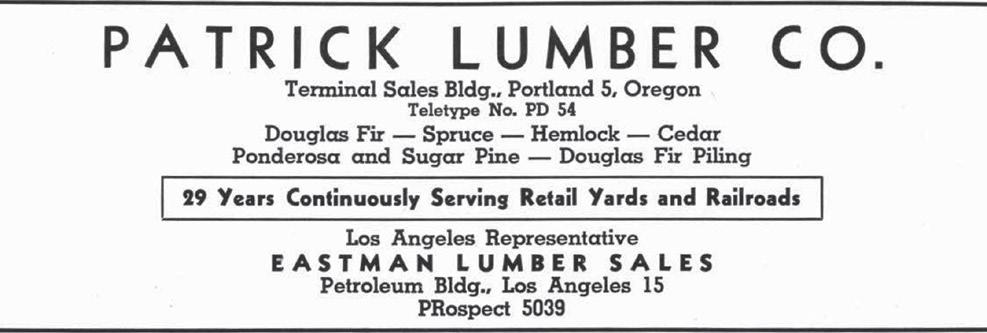
3 minute read
centennial FlaShBack
The 1940s
In honor of this year’s 100th anniversay of The Merchant Magazine, we are looking back each month, decade by decade, at the advertisers that have long supported us and are still growing strong to this day.
The 1940s were marked by a challenging world war that placed tremendous pressures on the industry and was followed by a gradual build-up to the boom that would detonate in the next decade.

• Rosboro started up its new state-ofthe-art lumber mill in Springfield, Or., in 1940 and began promoting its wares in the pages of The Merchant Magazine a year later—in December of 1941, billing it as the “Northwest’s most modern timber manufacturing plant.” Rosboro would expand to plywood in 1959, to glulam in 1963, and later to such industry-application-specific solutions as X-Beam and Treated X-Beam.

• TECO (Timber Engineering Co.) began producing “split-ring connectors” in 1934 for assembling heavy timber construction, including bridges, industrial facilities, and water towers. The connectors were invaluable during World War II, drafted into service in countless applications from building blimp hangars for the Navy to munitions factories for the Army (as spotlighted in it first marketing in The Merchant, a September 1942 co-op ad with distributor Weyerhaeuser.
In the late 1980s, TECO discontinued manufacturing and selling wood-related fasteners and connectors, instead concentrating on its research and testing services. In 2015, TECO merged with PFS Corp. and now does business as PFS TECO.
• Patrick Lumber Co., Portland, Or., was founded in 1915, initially serving retails yards and railroads, as shown in its first Merchant ad in May 1944. Now a large portion of its business is worldwide.

• Building Material Distributors—soon to be known as BMD—began in Stockton, Ca., in 1943, representing such lines as Yates & Smart Paint (as advertised in September 1946). Intent on becoming a national company, BMD moved to a larger headquarters in Galt, Ca., in 1974 and now has distribution, millwork showroom, and manufacturing operations across the country.



• Johns Manville had been manufacturing roofing shingles and more for generations before beginning a promotional blitz during the last year of World War II. The company realized that, with the conflict winding to a close, it needed to reestablish its good name in time for the anticipated building boom. JM took an unusual tackusing its radio commercials to “let people get to know us better” and then using print ads (such as the spread above from The Merchant Magazine in June of 1944) to “report on” its broadcasts.
The manufacturer later expanded to other lines, including acoustical products, and in 2001 became a wholly owned subsidiary of Berkshire Hathaway.

• Spotnails opened in 1941 to produce “automatic, magazine-fed” nailing and stapling tools and fasteners. It introduced the Spotnailer line to Merchant readers in December 1947, about a decade before it would help pioneer the first portable pneumatic nail gun. The company got the idea for its clever “pop-it” type air system from the technology used in the pilot ejection seats of fighter aircrafts. To this day, the “pop-it” technique is the primary method used to overcome recoil and drive long fasteners.
Spotnails was later purchased by American Brands’ Swingline, Inc.; sold to management in 1983, and then to South Korea’s Peace Industries in 1991. It remains a vibrant producer of industrial fastening products, including nails, staples, pins, brads and pneumatic tools.










